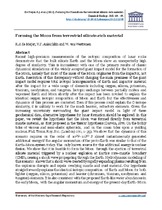| dc.description.abstract | Recent high-precision measurements of the isotopic composition of lunar rocks demonstrate that the bulk
silicate Earth and the Moon show an unexpectedly high degree of similarity. This is inconsistent with one
of the primary results of classic dynamical simulations of the widely accepted giant impact model for the
formation of the Moon, namely that most of the mass of the Moon originates from the impactor, not Earth.
Resolution of this discrepancy without changing the main premises of the giant impact model requires total
isotopic homogenisation of Earth and impactor material after the impact for a wide range of elements including
oxygen, silicon, potassium, titanium, neodymium, and tungsten. Isotopic exchange between partially
molten and vaporised Earth and Moon shortly after the impact has been invoked to explain the identical
oxygen isotopic composition of Moon and Earth but the effectiveness and dynamics of this process are
contested. Even if this process could explain the O isotope similarity, it is unlikely to work for the much heavier,
refractory elements. Given the increasing uncertainty surrounding the giant impact model in light of these
geochemical data, alternative hypotheses for lunar formation should be explored.
In this paper, we revisit the hypothesis that the Moon was formed directly from terrestrial mantle material, as
first proposed in the ‘fission’ hypothesis (Darwin, 1879. On the bodily tides of viscous and semi-elastic spheroids,
and on the ocean tides upon a yielding nucleus. Phil. Trans. Roy. Soc. (London) 170, 1–35). We show that the
dynamics of this scenario requires on the order of 1029–1030 J almost instantaneously generated additional
energy if the angular momentum of the proto-Earth was similar to that of the Earth–Moon system today. The
only known source for this additional energy is nuclear fission. We show that it is feasible to form the Moon
through the ejection of terrestrial silicate material triggered by a nuclear explosion at Earth's core–mantle
boundary (CMB), causing a shockwave propagating through the Earth. Hydrodynamicmodelling of this scenario
shows that a shock wave created by rapidly expanding plasma resulting from the explosion disrupts and expels
overlyingmantle and crust material.Our hypothesis straightforwardly explains the identical isotopic composition
of Earth and Moon for both lighter (oxygen, silicon, potassium) and heavier (chromium, titanium, neodymium
and tungsten) elements. It is also consistent with the proposed Earth-like water abundances in the early Moon,
with the angular momentum and energy of the present-day Earth–Moon system, and with the early formation
of a ‘hidden reservoir’ at Earth's CMB that is not present in the Moon. | en_US |

